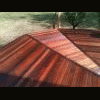Cold Water vs. Hot Water
Water in itself is a universal solvent and is a formidable cleaning tool. The temperature of the water changes how it affects solids in their existing state. Oil for example is not emulsified by cold water and in fact becomes more adhesive to itself as the temperatures drop. As the temperature of water is increased, it starts to break up the oils adhesive characteristics causing emulsification (suspension into solution) and makes it easier to remove. Hot water also allows chemicals mixed into it to work better and to be absorbed into solution easier. This can be observed by mixing a powdered cleaner into cold water and noting an undissolved residue at the bottom of the pail, while mixing the same powdered cleaner to hot water will dissolve easily leaving little or no residue at the bottom of the pail.
What is that chalky substance on the sides of a house?
This is caused by oxidation. It occurs when paint has been oxidized by exposure to either sunlight or a strong oxidizer like bleach (Sodium Hypochlorite). The exposed paint is broken down and the original color is lost in this process which is seen on painted homes and siding like aluminum. It can also be seen on vinyl type siding that has been exposed to high concentrations of bleach.
What is a 2 step process for cleaning a house?
This is referring to 2 types of chemicals being used one after the other. First an acid based detergent is applied to one side of the house and then an alkaline based detergent is applied on top of it before the first is allowed to dry. This sets up a reaction with the 2 that helps to break up and dissolve many pollutants that can be found on homes siding. Then both are rinsed away with a pressure washer using a wide nozzle, usually 40 degree tip for the least impact on the surface.
What types of acids and alkaline detergents are used in a 2 step process?
Acid based detergents contain active ingredients like Hydrofluoric, Hydrochloric, Sulfuric and Phosphoric acids. Alkaline based detergents contain active ingredients like Sodium Hydroxide, Potassium Hydroxide, Sodium Metasilicate and Limonene.
Are these compatible with bleach?
It is not recommended that you mix bleach with any of these active ingredients due to the possibility of causing a fire, release of hazardous gases or causing pressurization in a closed container which could lead to an explosion.
What happens if you get a lot of water behind the siding when washing?
The weep holes under the edges of the siding are large enough to allow moisture in small amounts to escape, but not large enough to handle large volumes of water introduced by pressure washing. The result is a cascade of water flowing down behind the siding that can then wick its way under the insulation and create moisture penetration into the framework of the home. The result could be water damage to the interior of the home, electrical shorts and circuit failures, mold and mildew proliferation and siding that will be bulged out wards due to water absorption into the particle board used in home construction.
How do I wash a house without creating a problem behind the siding?
Washing a home with a low pressure approach helps to minimize the introduction of water behind the siding. Although it does not prevent it, there is much less water for the weep holes to drain. Other methods include using a brush or rotary brush to remove any unwanted soil from the siding. Low pressure washing involves keeping the pressure below 300 psi like what is available out of the hose bib. Low pressure washing is applicable for removal of microbial infestations such as mold/mildew and algae with an antimicrobial cleaner. For removal of oxidation, egg, bat and wasp excrement, higher pressure may be required to agitate the surface in order to remove these unwanted contaminants.
Am I liable for any damage behind the siding?
Without a damage waiver, the answer is yes. Because you are the contract cleaner, you are supposed to be aware of the potentials for causing or creating damage in the processes you will use to clean a house. The best practice is to inform the home owner of the potentials and if they wish to proceed, they should be asked to sign a waiver to the fact. While this may leave the homeowner with the problem to deal with in the future, ultimately it is their choice whether or not the wash is to be done.
How do the chemicals I use to clean the house affect the plants?
Left alone to continue their action, chemicals can damage or even kill many plants found growing around a home. Thorough and frequent rinsing can help reduce the impact on them often will leave them well watered.
I heard that Hot water can be bad on vinyl siding, why?
Hot water in excess of 120 degrees can cause some types of vinyl to buckle, shrink and warp. This is one case where hot water can be bad for the surface you are cleaning. Note, in cold weather that using hot water in excess of 180 degrees can cause some windows (lead depression era glass and others made during that period) to crack.
How do I reach those high places when the ground isn’t suitable for a ladder?
There are “at the gun” nozzles called X-jets or M-5 jets that allow you to throw chemicals up higher to reach these areas. To rinse, using an extension pole of 18-24 feet helps to get you close to the surface in high places.
Should I use a wax after cleaning a house?
This is up to the customer, but the benefit should be explained for their consideration. House waxes can help to keep the surface clean for a longer period before needing another wash. They can also make the surface more resistant to mildew and algae reformation. The benefit to the homeowner is a better looking home for a longer time and that can equate to savings for them. Waxes costs pennies on the dollar and are easy to apply. Some techniques for application will include the wax in the cleaner if it can withstand the solution. The best results are achieved by applying the wax once the house has first been cleaned and rinsed. The benefit for the operator is that you make more money on the job by up-selling this service and the return service will be easier to clean.








Recommended Comments
There are no comments to display.
Create an account or sign in to comment
You need to be a member in order to leave a comment
Create an account
Sign up for a new account in our community. It's easy!
Register a new accountSign in
Already have an account? Sign in here.
Sign In Now